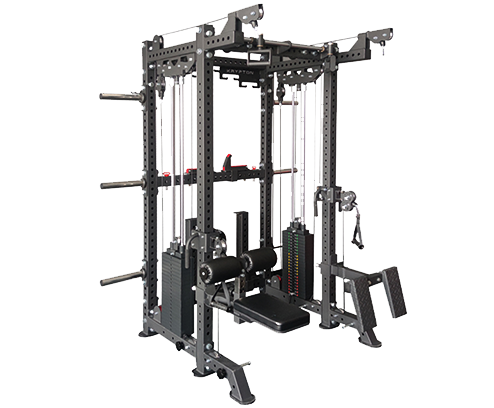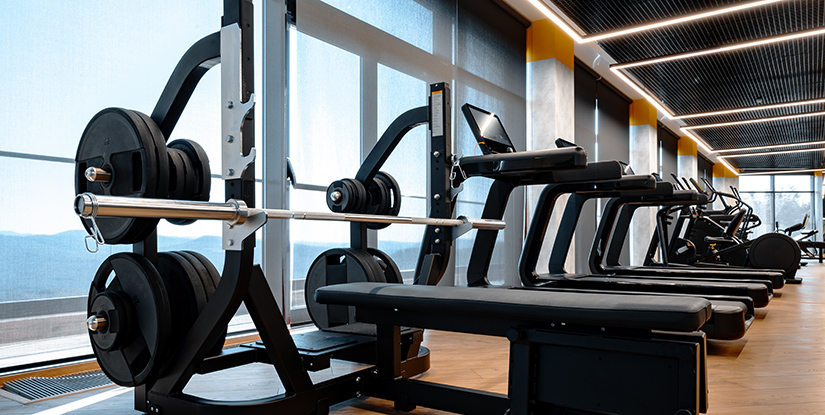The self-spotting bench press quickly became a problem I had to solve. I’d just started a new program that called for regular benching. But I didn’t have a gym buddy—and honestly, I wasn’t about to ask a stranger to spot me.
Also, I train at a busy commercial gym. People are doing their own thing. So I needed a way to bench safely on my own without holding back.
That’s when I started testing all the self-spotting options I could find.
Tried It All: My Experience with Solo Benching Options
So once I realized I had to figure this out, I tested every solo benching setup my commercial gym had. Here’s how it all went down:
Honestly, this felt the safest. I could bail easily if I needed to. But loading heavy was annoying, and getting into position with big weights? Super awkward. Great for higher reps, though.
- Smith Machine:
Set-up was easy. The bar’s locked into a track, so I didn’t worry about it falling. But yeah… it felt a little weird. The fixed path messed with my groove, especially on heavier sets. Still, it’s solid if you just want a quick, safe bench session.
- Power Rack with Safeties:
This one hit different. Took more time to set up, but once those safeties were in place, I felt locked in. I could go hard without the mental “what if I get stuck?” playing in the background. Not every gym has open racks, though, so sometimes I had to wait.
- Flat Bench, No Spotter:
Big nope. I tried it once—super light. But even then, I didn’t like it. My form was off ’cause I was too focused on not failing. The mental block was real. Wouldn’t recommend unless you’re very confident and staying submaximal.

Smith Machine vs. Free Weights: What I Noticed
After messing around with both, here’s the deal.
Pros of the Smith Machine:
First off, it’s super beginner-friendly. Honestly, I didn’t even need a spotter—just twisted the bar and racked it, easy as that. So yeah, that alone gave me the guts to load a bit more weight without stressing every single rep. Also, I could set up fast and knock out my sets without waiting on anyone.
Cons of the Smith Machine:
However, the bar path is fixed—and that messed with my natural groove. I noticed some weird pressure in my shoulders when I wasn’t lined up just right. It felt a bit robotic, if that makes sense. Unlike a regular bench, it didn’t let me move how I naturally would.
Overall Thoughts:
So yeah, the Smith machine definitely helped me train hard without worrying about getting stuck. That was huge. But it’s not a full-on replacement for free weights. For pure strength gains and a more “real” feel, free weights still win. That said, in a busy gym with no spotter? Smith machine all day.
My “Self-Spotting Bench Press” Setup That Actually Worked
So yeah, I had to get creative.
I mainly stuck with the Smith machine for my heavy bench days. Honestly, it let me push without stressing over getting pinned. The setup was quick, and I didn’t need to ask anyone for a spot—huge win.
On other days, I’d swap in dumbbell bench for more volume work. The drop safety was built-in (just let ’em fall if needed), so I could really chase fatigue without fear. Plus, it helped with stabilizer muscles, which felt like a bonus.
Occasionally, when the power rack was free, I’d use it with safeties set just above my chest. That gave me more confidence to work closer to failure, but yeah—it took time to set up and wasn’t always available.
So overall? I rotated between these depending on my goal that day. I focused more on volume, control, and clean form—not just maxing out. That mindset shift made training solo way less stressful.
So what’s your go-to move on self-spotting bench press days? Anyone else skip the barbell and stick with the Smith or dumbbells when training solo at the gym?
FAQs about Self Spotting Bench Press
Spotting yourself on a bench press can be challenging but not impossible. Here are some tips to help you do it safely:
Use Safety Pins or a Power Rack: Set up safety pins at a height just below your chest. This way, if the bar slips, it will land on the pins and not on your body.
Start with Lighter Weights: Begin with weights you are confident you can lift without assistance. Gradually increase the weight as you get more comfortable.
Incline Bench Press: An incline bench press can be safer to perform alone because it reduces the range of motion.
Dumbbell Presses: Dumbbells can provide more control and are easier to drop safely if needed.
Focus on Form: Proper form reduces the risk of injury. Make sure your back is flat, your buttocks stay on the bench, and your feet are firmly planted on the ground.
Spotting in bench press means having someone assist you during the lift to ensure safety and effectiveness. A spotter stands near your head or behind you, ready to help if you struggle to lift the barbell. Their primary responsibilities include:
Lifting Off: Assisting with the initial lift off the rack.
Guidance: Providing verbal encouragement and form corrections.
Assist with Failed Lifts: Helping to lift the bar if you cannot complete a rep.
Prevent Accidents: Ensuring the bar doesn’t fall on you, significantly reducing the risk of injuries.
Bench pressing without a spotter can be safe if you follow proper precautions:
Use Safety Equipment: Employ safety pins, a power rack, or a Smith machine to catch the bar if you fail a lift.
Know Your Limit: Never attempt to lift more than you’re confident you can handle alone.
Dumbbells Over Barbells: Dumbbells are easier to discard if something goes wrong.
Close-Grip Bench Press: This can be safer than other forms since it puts less strain on your shoulders and makes it easier to maneuver the bar.
Increasing your bench press without a spotter requires extra caution and strategic approaches:
Progressive Overload: Gradually increase the weight you lift to avoid overstraining.
Proper Form: Ensure you maintain proper form to prevent injuries and improve lift efficiency.
Safety Measures: Use safety pins or a power rack to allow for safe maximum lifts.
Accessory Exercises: Strengthen supporting muscles with exercises like tricep dips, push-ups, and shoulder presses.
Rest and Recovery: Allow your muscles to recover with adequate rest and nutrition. Overtraining can lead to injuries and setbacks.
By following these guidelines, you can effectively and safely perform the bench press exercise and aim for increases in your lifting capacity.

Hi, I’m the editor here at Leadman Fitness. We’re a manufacturer focused on producing top-quality barbells, plates, kettlebells, dumbbells, and strength training gear. I’ve been into sports and fitness for years, and I know my way around all kinds of gym equipment—both from using it and helping create it.
I spend a lot of time understanding the real problems people run into in the gym—whether it’s beginners trying to pick the right gear or experienced lifters looking for something more durable. I stay in close touch with our production team and talk directly with other equipment makers, so we’re always improving based on what real lifters and coaches are looking for.
What I share comes from hands-on experience—stuff that actually helps people train better, not just in theory, but in real gyms.
